The Berkshires in Winter | An Insider’s Guide
From dining and culture to winter sports, one discovery leads to the next when you visit the Berkshires in its most intimate season.
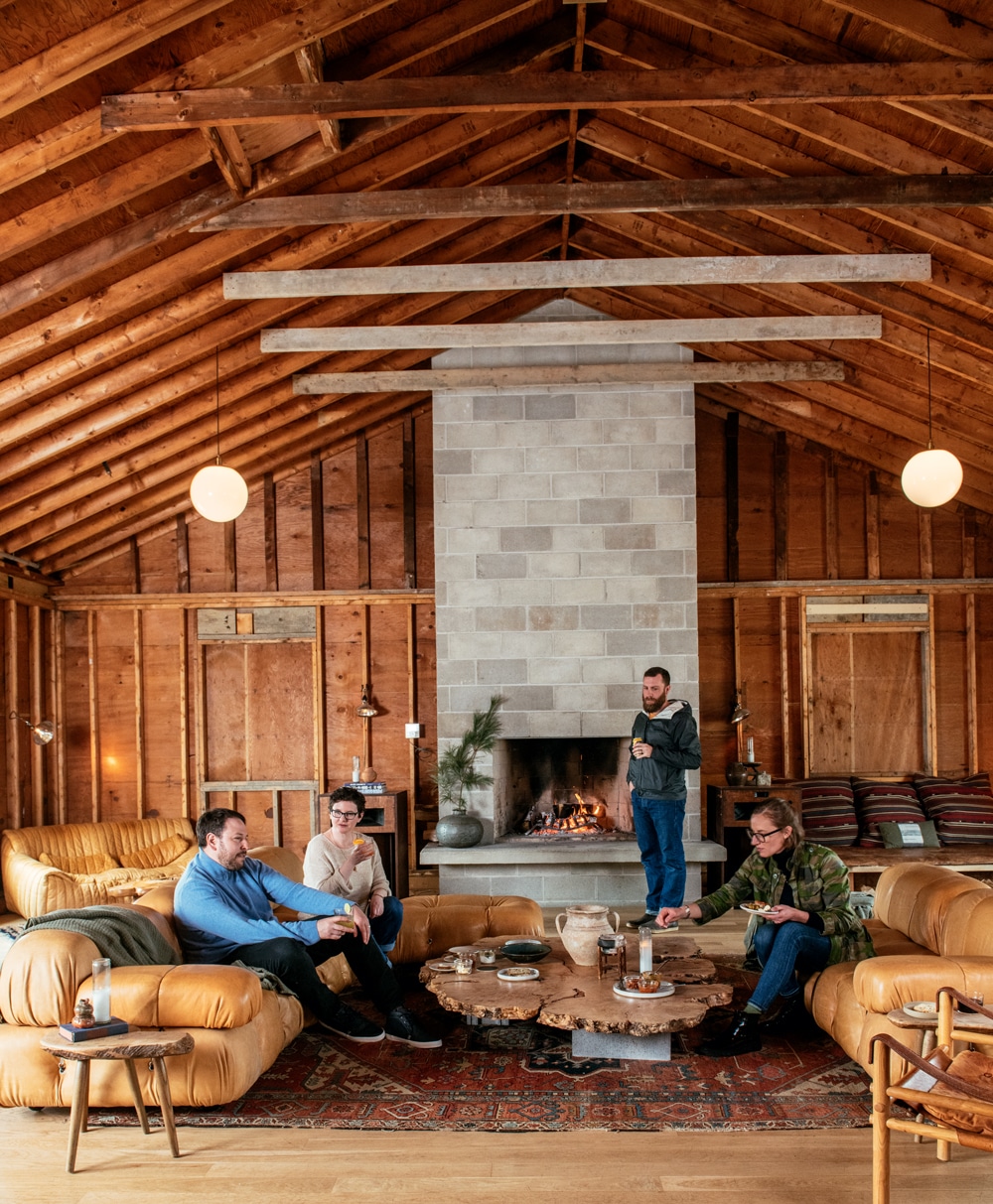
Coffee By Design | Portland, Maine
Photo Credit : Katherine KeenanI grew up in a vegetarian bed-and-breakfast in the Berkshires of Western Massachusetts. Back in the 1970s, my grandparents discovered an old stagecoach stop in ruins and, eager to move on from the New Jersey suburbs, transformed it into a haven for any traveler in search of a bacon-less breakfast.
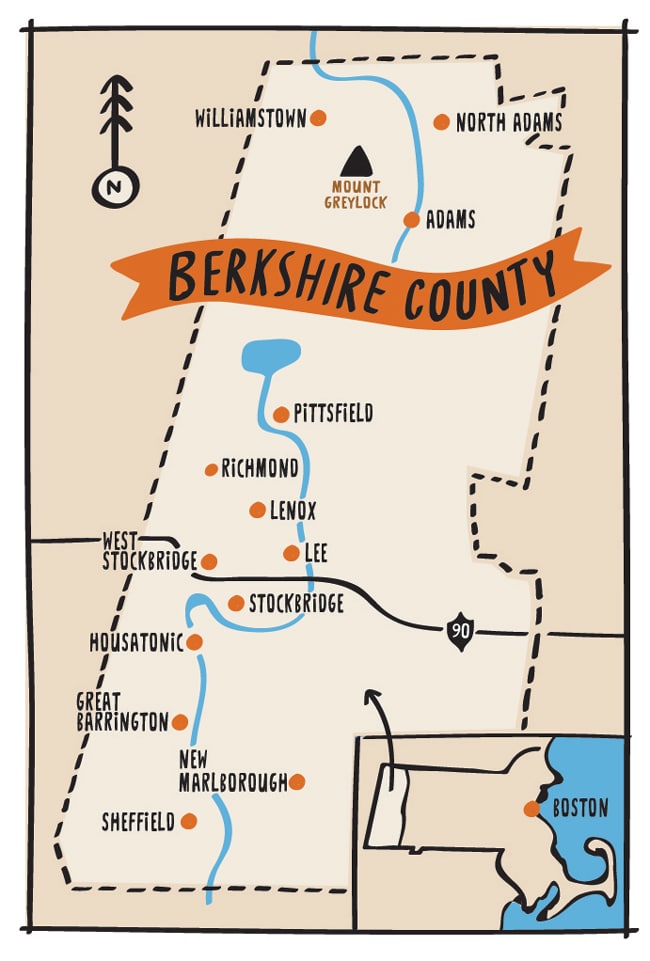
Photo Credit : Nate Padavick
They found two huge slabs of chestnut in the walls, valuable wood that was apparently hidden from the king’s tax men before the War of Independence. They turned each slab into a table, maintaining the natural edge so that guests had to fit their chairs between its swirls and curves. My grandmother gave me the late-night job of setting the tables for breakfast, and I’d run my hand along the edges with the thought of that wood hidden away so long as the house itself passed through time, rooted in place.
In the morning I was a fly on the wall, ears perked for conversation from the guests: Tanglewood musicians in the summer, skiers enjoying snowy weekends in the winter. My family was surrounded by visitors, and although many locals would roll their eyes at tourists, I wanted so much to be a visitor myself. Travelers arrive with a sense of curiosity that we can lose when we get too comfortable and familiar with a place. Even then, I looked to the guests to help me see with new eyes where I was from.
Years later, I came back home to the Berkshires with a husband and a pregnant belly, ready to find my life here as an adult. My husband, Joey, is from Colorado, and he discovered something to enchant him every day: covered bridges, swimming holes, harvest festivals, cider doughnuts. I came along for the ride, happy to experience home in a new way.
—
Berkshire County is long and thin, and it takes just over an hour to drive from one far end to the other. It’s the crunchy western edge of the Massachusetts brownie pan, wedged in by Vermont, New York, and Connecticut. It’s an inland haven, both central and secluded, often spoken about in relationship to other places. The original stagecoach stop that became my grandparents’ inn was hailed as the exact midway point between Boston and New York City. (It’s family lore, but I’ve never been tempted to discredit it.)
There is a divide between north and south in this region, with the shift occurring somewhere in Pittsfield, the county’s largest city. The divide is economic and cultural, and those who grow up here tend to be fiercely territorial about the split. But for me the most striking difference between the southern and northern Berkshires is in the topography. Start in the south, and the low, flat farmlands alternate with gentle cobbles and hills. Head north, and the hills get bigger, and by the time you’ve reached North Adams they’ve transformed into dramatic crags and valleys, taking a cue from the king, Mount Greylock, which towers above the towns.
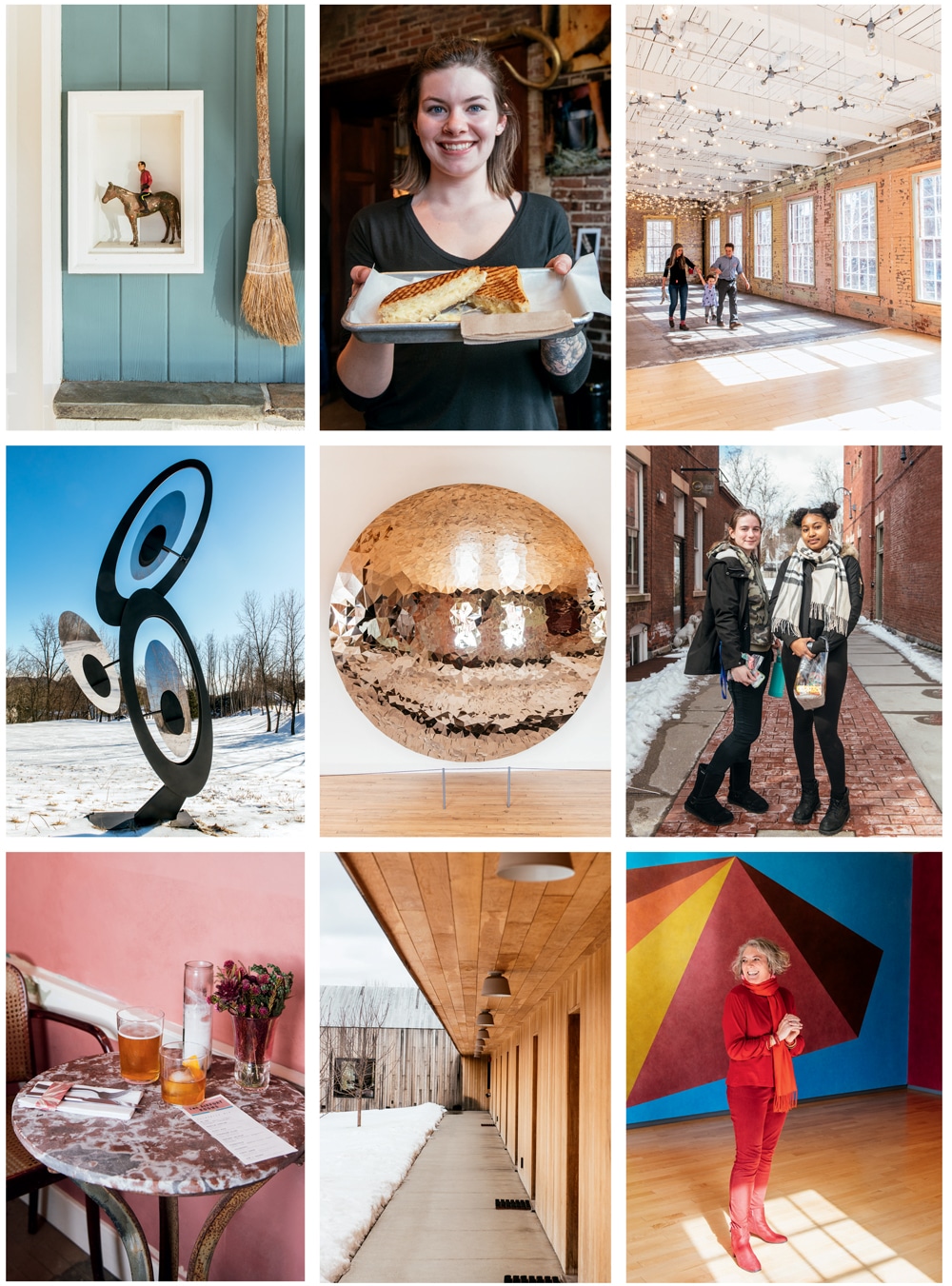
Photo Credit : Gabriela Herman
But winter offers a slower, more intimate time, when the line between visitor and local blurs. There’s plenty of room for us all. We have the museums to ourselves, we can always get the table by the fireplace at restaurants, and there’s little traffic to disturb the snow on the trails that lace the county. And it’s this Berkshires that calls to us now.
—
We begin in the north by watching the snow from the window seat of our room at Tourists, a newish hotel in North Adams. It’s easy to miss as you drive Route 2 between Williamstown and North Adams: There’s a small sign, a parking lot, and a wall of wood with a line of doors that blends into the forest behind it. No windows face the road, so the buildings keep the secret of the nature-focused minimalist rooms, each of which has a large picture window and a private outdoor space complete with a shower.
As new as it all feels, there’s an element of history in the walls, a rekindling of the glory days of road trips. Tourists sits on the footprint of an old motel that flourished in a time when car after car would journey down this stretch of the Mohawk Trail, America’s first scenic byway. The hotel took its name from the era when every business that welcomed travelers indicated its hospitality with a sign that simply said “Tourists.” One of these old signs sits in the hotel for inspiration.“I think we’re reclaiming the word a bit,” Nina Zacek Konsa, the hotel manager, told me by the huge fireplace in the lodge. “It can have a negative connotation, but we’re really all travelers, in a way. We’re welcoming people who are coming through, taking in the sights, having an adventure.”
It works for me. Our own adventure starts with a snowy trek across the property to the hotel bar, dubbed the Airport Rooms. It’s an entire house filled with perfect corners for cocktails. The wallpaper has been restored to its original glamour, and the feel is that of another place and time. The cocktail menu is all classics. I have a Godfather—scotch, amaretto, and sherry—and Joey has a beer, and we sit on a velvet couch by the window as the band starts to play.

Photo Credit : Gabriela Herman
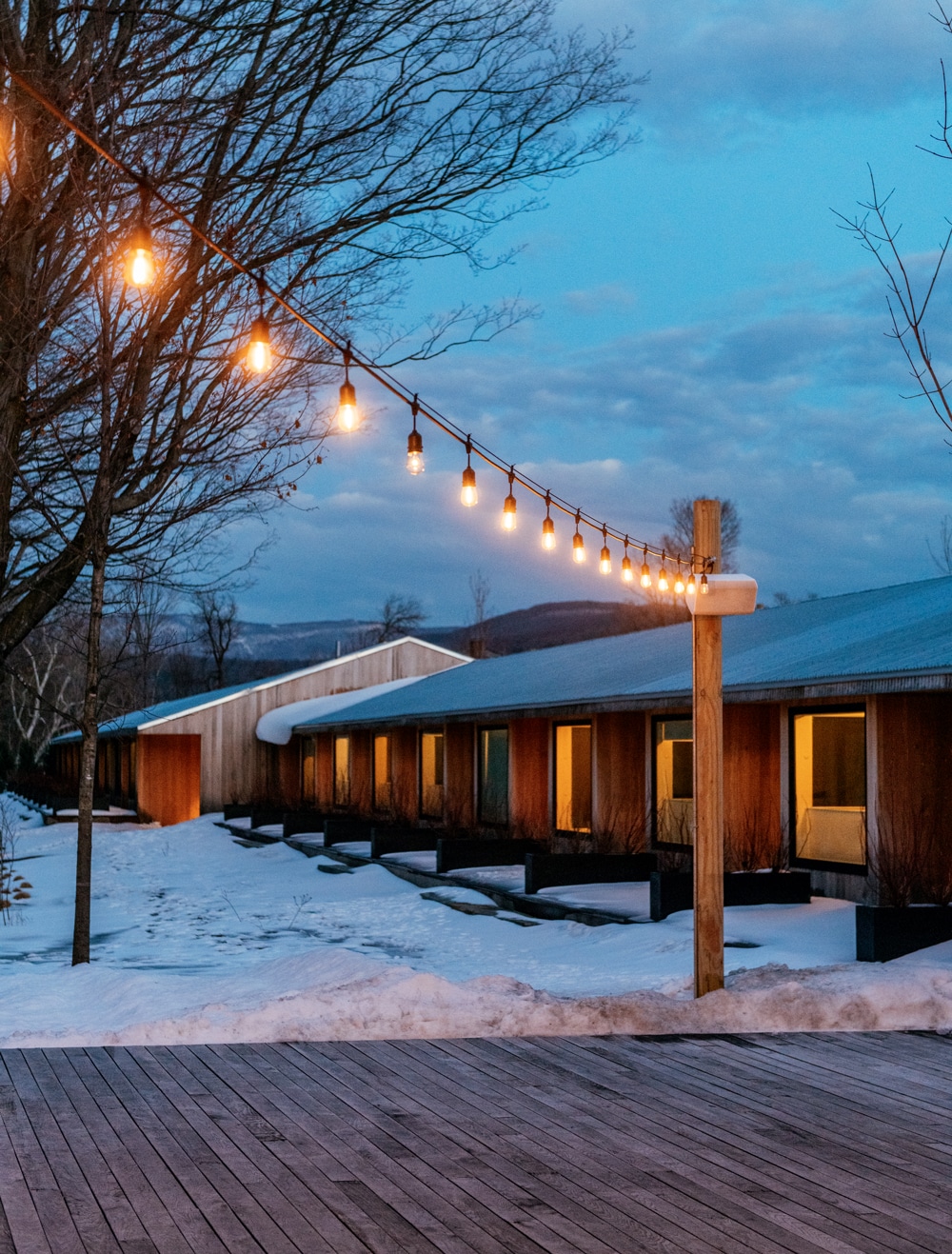
Photo Credit : Gabriela Herman

Photo Credit : Gabriela Herman
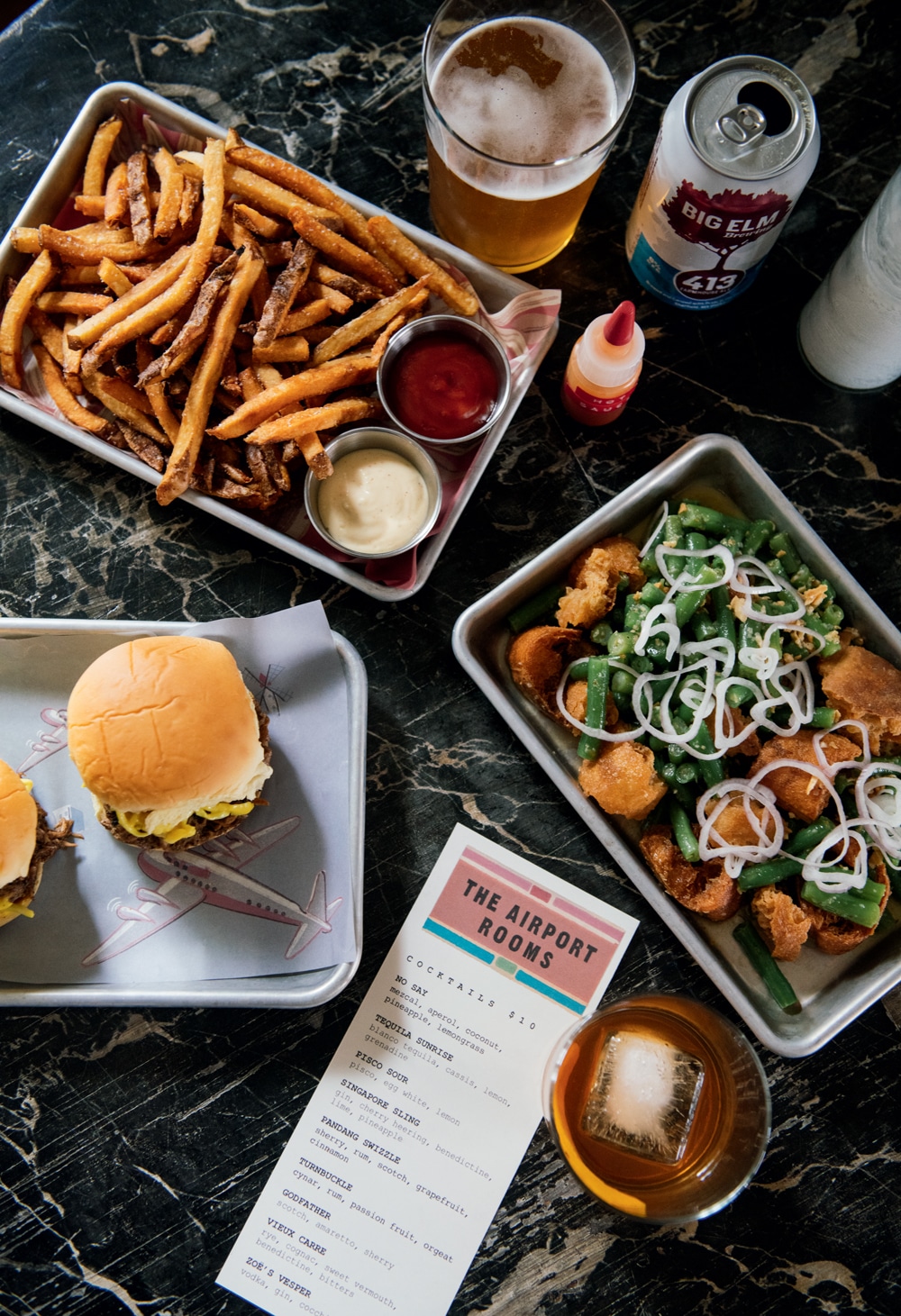
Photo Credit : Gabriela Herman
Then it’s time for dinner. After a quick drive to Williamstown, we park at the base of a hill and climb up to Mezze, usually a special-occasion place with fine tablecloths and elevated farm-to-table cuisine. But arrive midweek at this time of year, and you just might find an additional “research and development” menu. Most restaurants here mix it up during winter: prix fixes, themed nights, anything to get the locals out. I love this R&D idea, and I ask Nancy Thomas, Mezze’s owner, how it came about. She’s a wisp of a woman, small and strong, of Greek and Moroccan descent. She bounces from table to table, saying hi to old friends, checking in on new ones, all with an ease that takes any formality right out of the room.
“Our team has been wanting to create more casual food, and in the winter we can play, relax, and have more fun,” she says. “It’s different in the summer; we just have to do what works and do it constantly. But this time is great—everyone comes out.” I can see it, too. The dining room is filled with locals. Most people recognize one another, and everyone knows Nancy.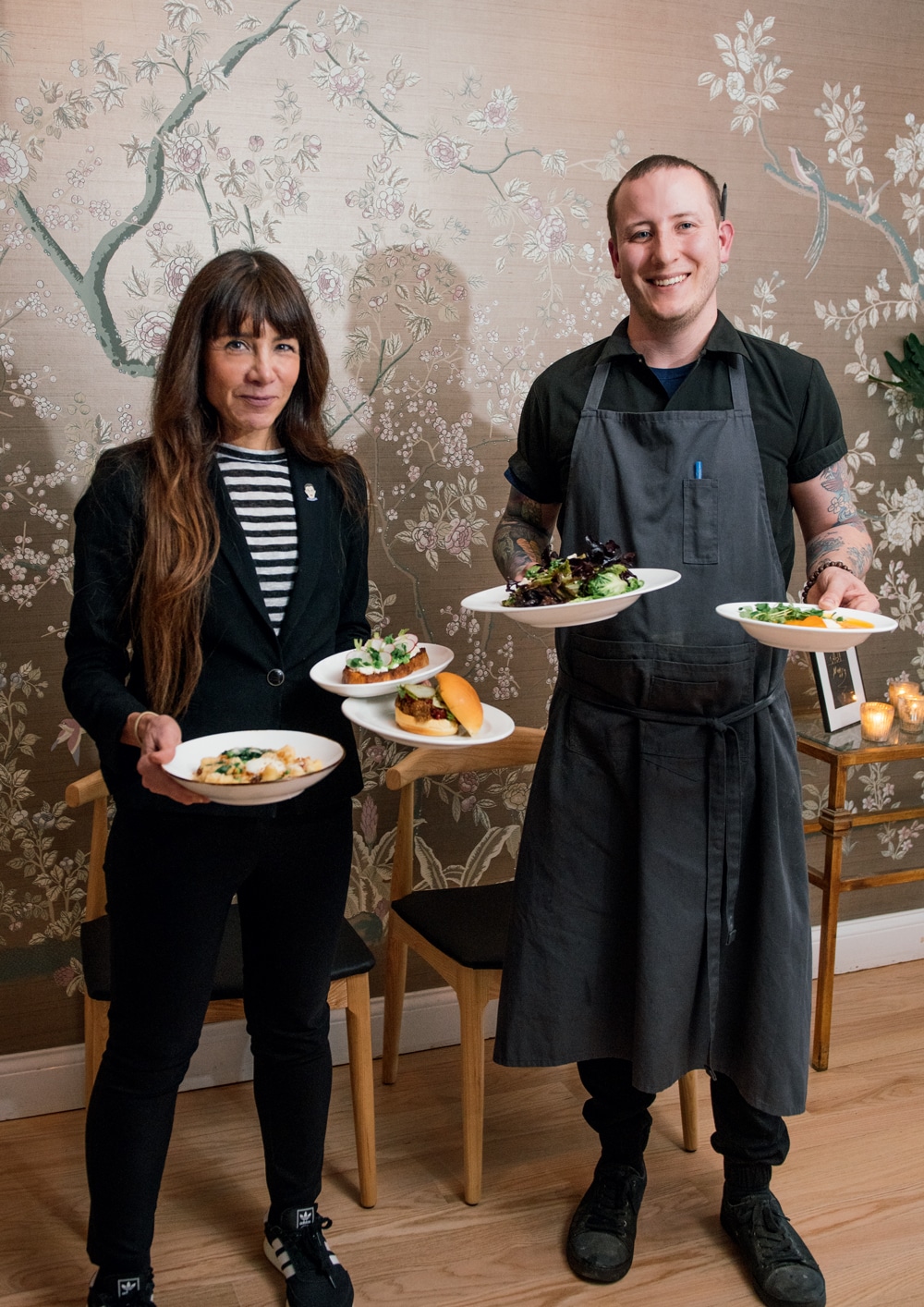
Photo Credit : Gabriela Herman
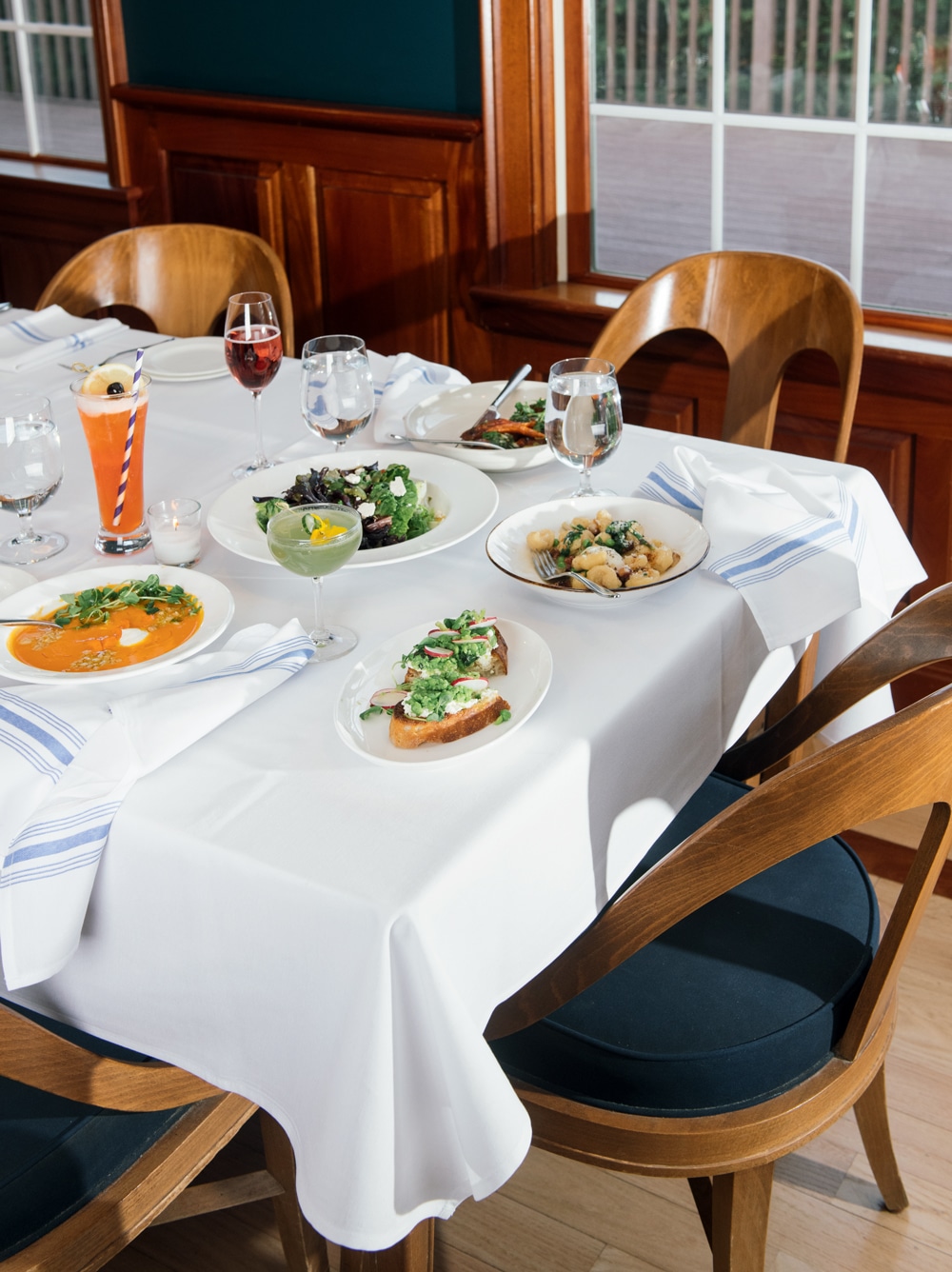
Photo Credit : Gabriela Herman
—
Just 10 minutes apart on Route 2, Williamstown and North Adams sit at the northern boundary of the county: two towns so different, yet both all about art.
One of the country’s largest contemporary art museums, Mass MoCA, occupies a full campus of former mills in North Adams. The museum has been a force for change in town, and its presence has inspired new life for many of the old mills, from the light-filled event space of Greylock Works to Bright Ideas Brewing Company on the Mass MoCA campus to the live/work spaces available to artists in search of inexpensive studios.

Photo Credit : Gabriela Herman
North Adams is a town of visual layers—green steeples over red brick and gray canals. In the late 19th and early 20th centuries, the majority of residents worked in the textile mills, but although the town fell on hard times when those mills shut down, today it has the look and feel of an active community filled with industry. There’s a tension throughout the Berkshires between those who have lived here for generations and those who have come during this recent revitalization, especially in North Adams and Pittsfield, where the community boomed and fell over the course of the past century. But there remains a focus on history in the Berkshires, repurposing buildings in ways that honor their original intent, and tapping into ways to join the new and the old, to support the people who have been there all along.
You could spend two days at Mass MoCA alone (indeed, restaurants and hotels have grown up around the museum to help visitors do just that). On this day we head straight for the James Turrell show. We don protective socks over our shoes and step into a green-screen world that goes purple, then blue, then green again. I’ve seen this show over and over, and each time I enter thinking that the light won’t make me feel anything. And each time I leave filled with colors.
When we head next to Williamstown, the home of Williams College, the vibe changes instantly. Now pressed against the hills are pristine college buildings and crosswalks teeming with backpack-wearing students, phones in hand. We stop at the Williams College Museum of Art, which has exhibited some of the most provocative and creative work I’ve seen anywhere. We then follow the roundabout to the Clark, an art museum whose size and scope challenges any assumptions you might have about what you’ll find in rural Massachusetts. Who knew there were so many Degases out here in the country?
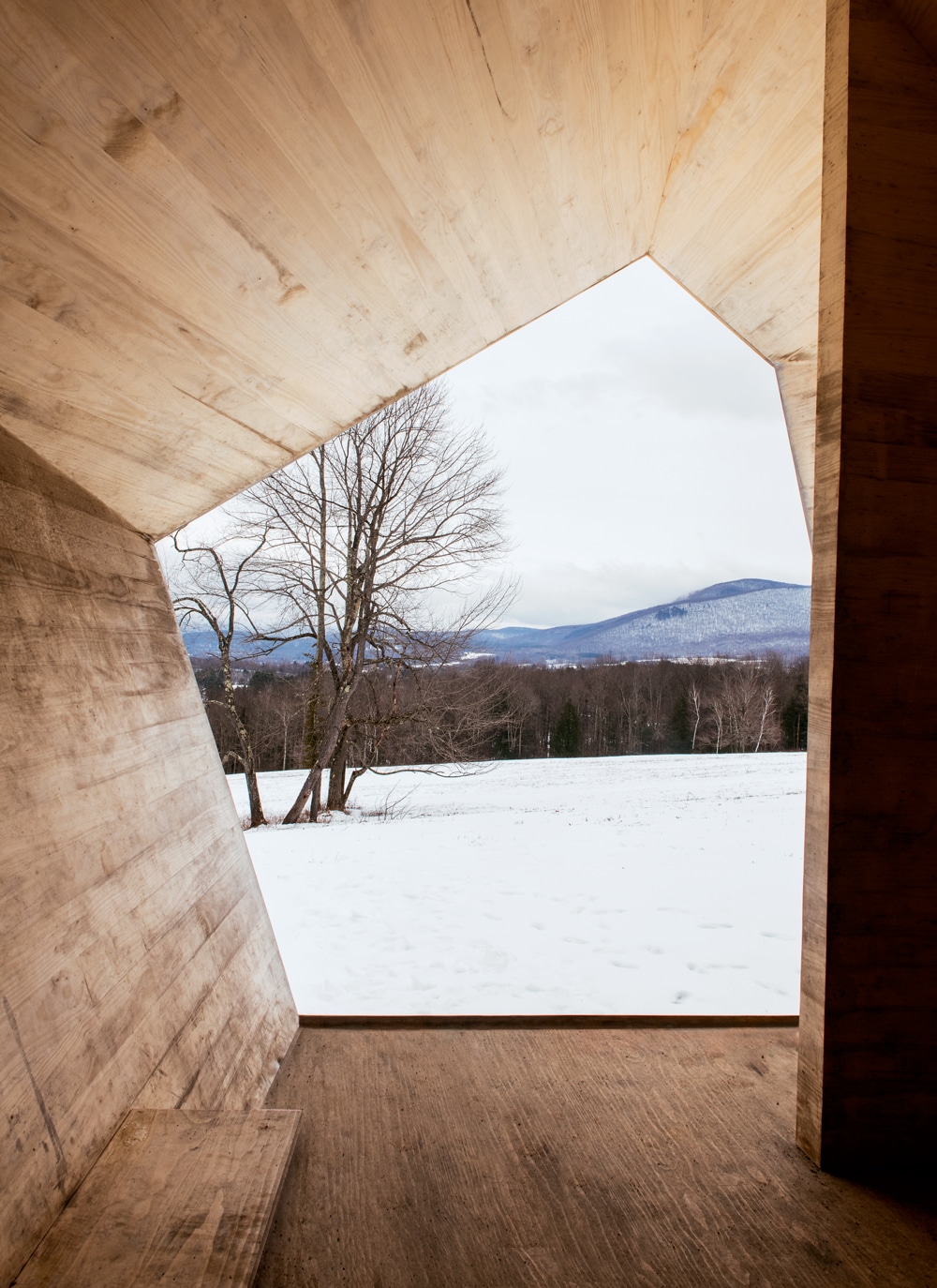
Photo Credit : Gabriela Herman
The art is all around us, even as we walk outside. There are 140 acres of meadows and trails here, with my favorite path leading up to the Clark’s Lunder Center at Stone Hill, a modest building designed by Tadeo Ando in 2008. It fits into the hillside almost as if it had grown there, and its two galleries lead out to minimalist wooden patios that invite a long look to the hills beyond. On our way in, we pass a stand with snowshoes for anyone to borrow, and I take note for next time, when there’s more snow.
Beginning our trip home, we motor down Route 7 through the rolling hills and farmland of Williamstown, into New Ashford (past the hotel sign that always says “Think Snow” no matter the season) toward the center of the county. As North Street in Pittsfield unfolds in front of us, we see just what we’d hoped we would: The sign above the Lantern Bar & Grill is illuminated, with great swirly letters that usher us inside the door, blinking snowflakes out of our eyelashes as we adjust to the warm lights of the bar.
The Lantern was a Pittsfield institution for a century, serving the city through its many permutations as industry came and went. When the third-generation owner closed the restaurant, Bjorn Somlo, a Berkshire native, chef, and Lantern customer, stepped in to keep it alive.
Two years later, the place is packed. We join in the warmth and chatter of the full room. Bjorn stops by our table and I congratulate him—it feels like the old Lantern through a new lens, clearer and, most of all, open.
“See that line?” He points to a meandering strip of inlaid wood and metal that divides the floor into two sections. “Everything on this side is exactly the same,” he says, gesturing to the wooden tables that glow with age, the pendant lights that bathe the room in deep gold and red, the chairs sculpted by the thousands of customers that have sat in them. “Everything on the other side of the line”—he pats the dark wooden bar, cocks his head toward the kitchen—“we updated.” If Bjorn hadn’t pointed it out, I’d have had no idea where the old ended and the new began. I realize that this little 60-seat restaurant, smack-dab in the center of Berkshire County, is a microcosm of the region itself—a merging of old and new, all working together to bring the community forward.
And of course, there still are the burgers. They come two on each plate, thin patties of grass-fed beef on squishy potato buns with a secret sauce that is spicy and creamy and perfect with the fries.
We head home full and happy, making plans to see the southern Berkshires through the eyes of travelers in the coming weeks. Although I drive that stretch of Route 7 between Pittsfield and Great Barrington nearly every day, I hope it will now look different, unfamiliar, glowing with the low light of the later sun that comes as we inch toward March.
—
The southern Berkshires are my stomping ground, so I need to slow down, put aside my to-do list, and look around. A few weeks have passed since our northern Berkshires adventure, and tiny signs of spring are beginning to show themselves, subtle markers of the gradual change of New England seasons.
I begin in West Stockbridge with coffee at Six Depot, run by our friends Flavio Lichtenthal and Lisa Landry. West Stockbridge is often overlooked, but it offers plenty to fill an afternoon, especially if you have a penchant for great coffee shops. The Williams River runs through downtown like a European canal. I get a strong hit of coffee as I walk over the bridge toward Depot Street. They must be roasting, and it smells amazing. I have a particular attachment to this coffee shop and gallery, as I remember standing in Flavio and Lisa’s kitchen while they went through possible names for their new venture. At that point they were experimenting with beans and roasts using a little home roaster. Even then, their coffee was the best I’d ever had. Now you can buy Six Depot coffee all over the Northeast.
I take a quick spin through the café gallery and carry my coffee over to TurnPark Art Space, a sculpture garden tucked into an old quarry behind the train station that holds Six Depot. The indoor section of the park closes in winter, but the grounds stay open for anyone to explore, winding up over the town with a secret path from sculpture to sculpture that makes me feel like I’m doing something deliciously forbidden. I’m alone with the sounds of the town and the river below me. I see someone on the crest of the hill and am careful not to disturb him as I pass by. In the end, it truly is just me and the sculptures, as the person turns out to be fixed there on the hill, a man of iron staring at the sky.
From there I head to the Mount, the grand estate of Edith Wharton. The author built her house here in 1902, in search of refuge from the “suffocating social climate” of Newport, Rhode Island. I’ve always loved the Mount. I’m a devoted Edith Wharton fan, and I especially appreciate the way she frames the Berkshires as a place for people, like her, who are outside the mainstream.
Berkshire County is, and always has been, the vacationland of outcasts and weirdos. People come here not to be seen, as in the Hamptons, but to get away, to create, and to absorb the vibe of what’s already here. Dancers and composers came and established institutions like Jacob’s Pillow Dance Festival and Tanglewood, and those migrations built the cultural institutions that form the heart of the county. It’s almost as if there’s something in the air that supports creativity and independence.

Photo Credit : Gabriela Herman
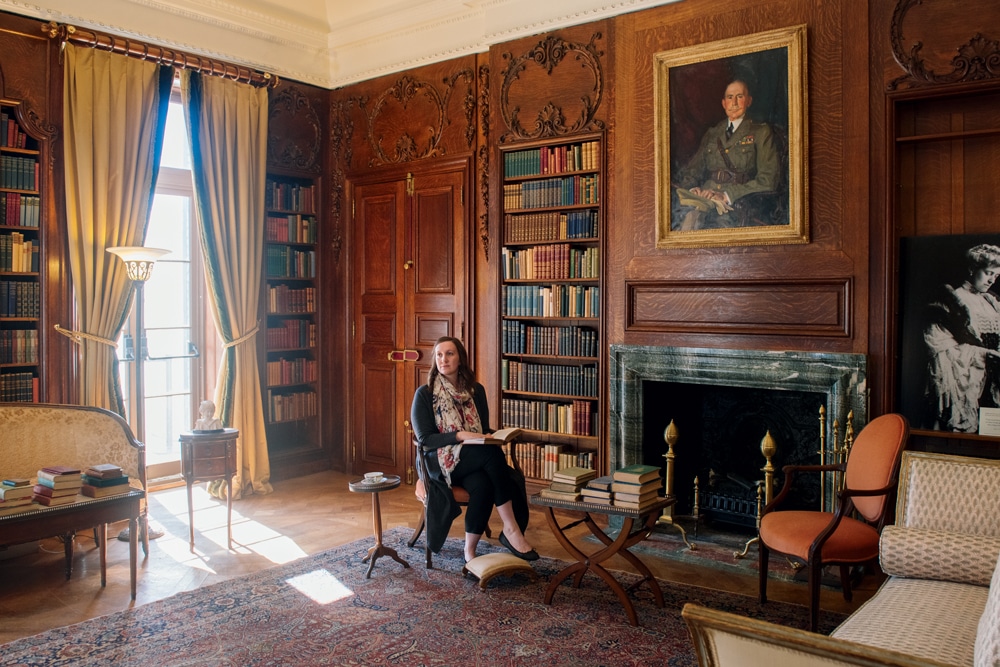
Photo Credit : Gabriela Herman
Anne Schuyler, director of visitor services at the Mount, walks with me down the arched hallway of the great house, our footsteps echoing against the marble floor. They’ve just started inviting people to visit during winter hours on Sundays. “With the smaller crowds and unhurried pace,” she explains, “they have the opportunity to experience the house in a much more intimate manner.” It’s true—it’s less of a museum right now, and more of a living and breathing home. Best of all, the oak-lined library, separated from tour-goers by a railing in the summer, has become part of the winter tour. Visitors can move beyond the partition into the heart of the library, to scan the leather books that line the walls as they did in Edith Wharton’s time. I’m tempted to recline on the fainting couch with a novel for the rest of the afternoon, but I blink and bring myself back to this time, now, reminding myself where and when I am.
—
There are some nonnegotiables when it comes to visiting the Berkshires, foremost of which is the Red Lion Inn, which has hosted travelers since 1773. It took me years to finally sip a cocktail in one of the massive rocking chairs on its iconic porch, and that early summer evening of watching people come and go from my perch above Stockbridge convinced me. The inn also offers winter travelers a heated outdoor pool and hot tub and guided snowshoeing, yoga, even ice fishing. That said, my Red Lion Inn and Stockbridge bucket list is a little nontraditional.
It’s a sunny Saturday in March, and the temperatures have climbed deep enough into the 40s to make people shed their coats and start every conversation by marveling over the warm weekend weather. Joey meets me in Widow Bingham’s Tavern, the cozy spot that provides a counterpoint to the inn’s more formal dining room. We share fish and chips, the ideal pairing for Lion’s Ale, a beer brewed specifically for the inn by Big Elm Brewing in Sheffield. But the highlight is dessert. A waiter once told me that chef Brian Alberg made a warm brown sugar cake in his job interview, and it’s been on the menu ever since. It comes to us with two spoons, served with caramel sauce and coffee ice cream from Great Barrington’s SoCo Creamery. It’s like a highbrow warm cider doughnut dunked in creamy coffee.
After finishing our meal, we assume the role of guests so we can venture upstairs. The hallways of the upper floors are like a secret museum, filled with quirky photographs and paintings, each with a story to tell. After a bit of exploring, we go back down to spend a few minutes in front of the vast fireplace with the inn’s resident cat.
Finally, following a pit stop in the greatest bathroom in the Berkshires (the wallpaper alone is worth a visit), we head off to explore Stockbridge: coffee and a new novel from Stockbridge Coffee & Tea; penny candy for our kids from the treasure-filled Williams & Sons Country Store. We take a quick drive to the Norman Rockwell Museum, where it’s impossible not to feel his commentary and reflections on humanity when you’re surrounded by his work. Best of all, sitting on a hill behind the museum is his studio, moved from its original location in downtown Stockbridge. It’s simple and small, and standing in it, I feel flush with ideas about how to improve the space where I work and write. I am inspired about creativity itself.
—
Great Barrington is, for many, the place to go in the Berkshires. Main Street is wide and lined with shops, restaurants, and real estate offices eager to turn visitors into residents. It’s the first day of spring, and Joey and I have taken the day off to spend it together. We weigh our lunch options, narrowing it down to grilled cheese or dumplings. We opt for both, starting in the grand old bank building that houses an excellent cheese shop, Rubiner’s, as well as its spin-off café, Rubi’s. At the latter there is an entire menu of grilled cheeses, each highlighting a different artisan cheese, but I always go for the classic comté on Pullman white, which is both the most affordable lunch in town (coming in at just over five bucks) and the greatest grilled cheese on the planet.
Then it’s a little second course of steamed rice dumplings and a chicken mushroom bun at Steam, just down the street. This hole-in-the-wall noodle joint opened a few years ago, and it’s become my favorite lunch spot. On the coldest winter days, all I crave is a huge steaming bowl of Steam’s kimchi ramen; you’ll often find me slurping noodles at the counter on my lunch hour.
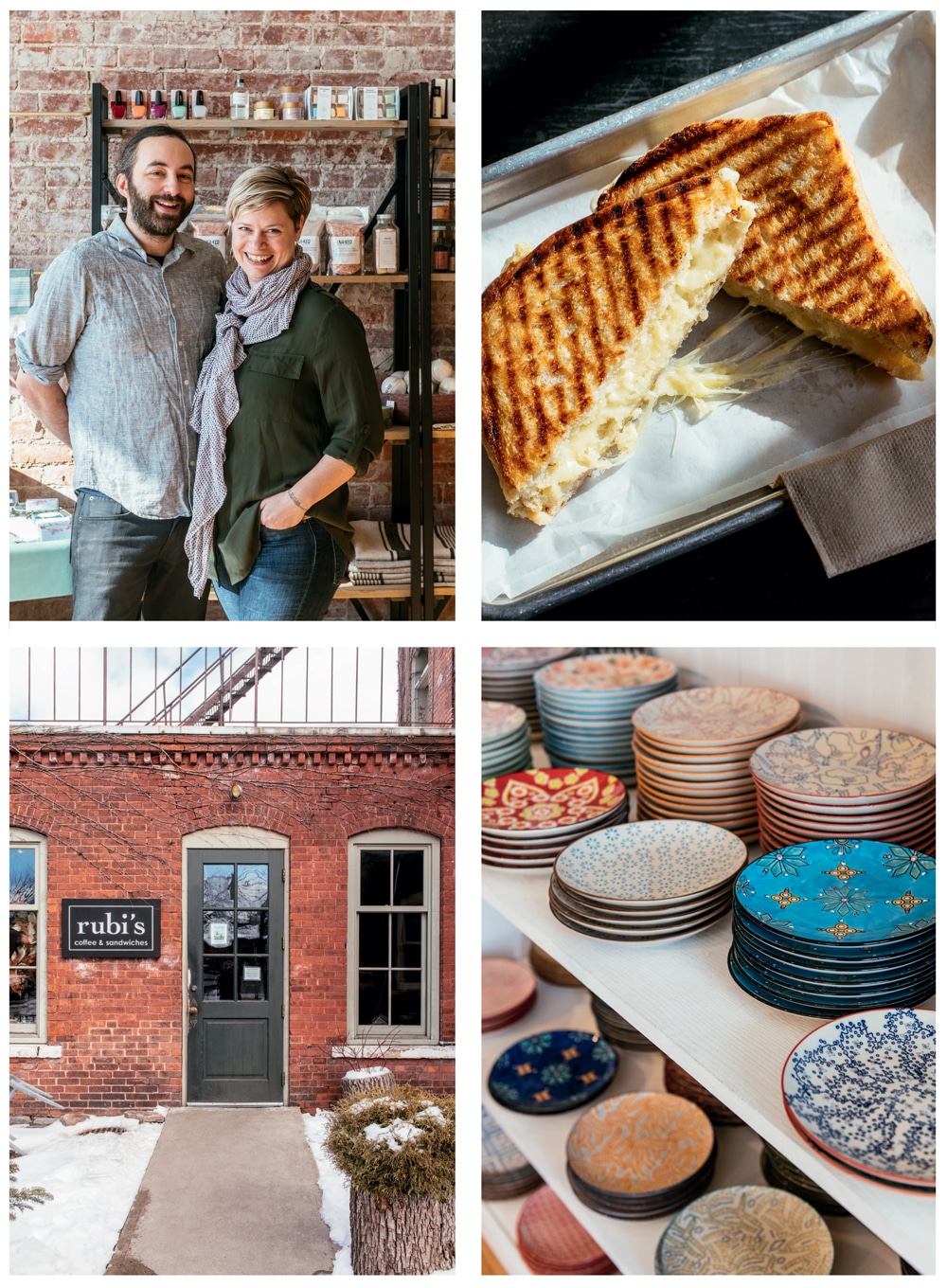
Photo Credit : Gabriela Herman
One street over is One Mercantile, my go-to for gifts, great cards, and whenever I need something new and beautiful for my home. The owners, Andy Pruhenski and Abby Webster, grew up here, as did (come to think of it) Bjorn Somlo of the Lantern. We’re all around the same age—late 30s, early 40s—and I realize how many people, whether they’ve come back or never left, have committed to staying in the Berkshires, helping to grow and reimagine the home that shaped them.
Our last stop in town is Yellow House Books, a used bookstore that occupies an actual yellow house right on Main Street. If you are someone who dreams of discovering a new poet or novel or book about the history of something you never even knew existed, Yellow House is a must-visit. Joey and I separate into different aisles and reemerge an hour later, each with a small stack in hand.
Joey and I agree that we should end this trip outside with a view. New snow is on the ground, and we stop at home to grab snowshoes and a thermos of local bourbon and cider. That, along with a Berkshire Mountain Bakery baguette and a wheel of Cricket Creek cheese, will be the last meal of our traveler’s journey across Berkshire County. We drive south on Route 7 past Berkshire Mountain Distillers, the source of our bourbon, and I think, too late, that I should have scheduled a tour. It’s a great way to pass a late afternoon, an education in farm to bottle that ends in a fantastic tasting. But we drive on, turning toward the little sign that marks Bartholomew’s Cobble.
There are two choices here. To the left is the cobble (the word refers to the type of a small rocky hill that’s common in this part of the country), whose trails make for an easy family hike, manageable for small children. But we go right, choosing a hike through the woods called Hurlburt’s Hill.
We strap on our snowshoes and start our ascent through the fresh snow. It’s not far to the top, and the trees open up onto a wide meadow that caps the rolling hill. The edge of the field is in Connecticut, but the view expands all the way to Vermont. If any spot was made for a picnic, it’s this one, and we take off our snowshoes and sit right there on the snow, taking in the full expanse of the distance we’ve traveled.
“Why don’t we do this more often?” Joey asks me.
I pour him a cup of steaming cider, tearing off a hunk of bread to spread with the soft cheese.
“You read my mind.”
—
An Insider’s Guide to the Berkshires | See, Shop, Eat & Stay
Berkshires Dining
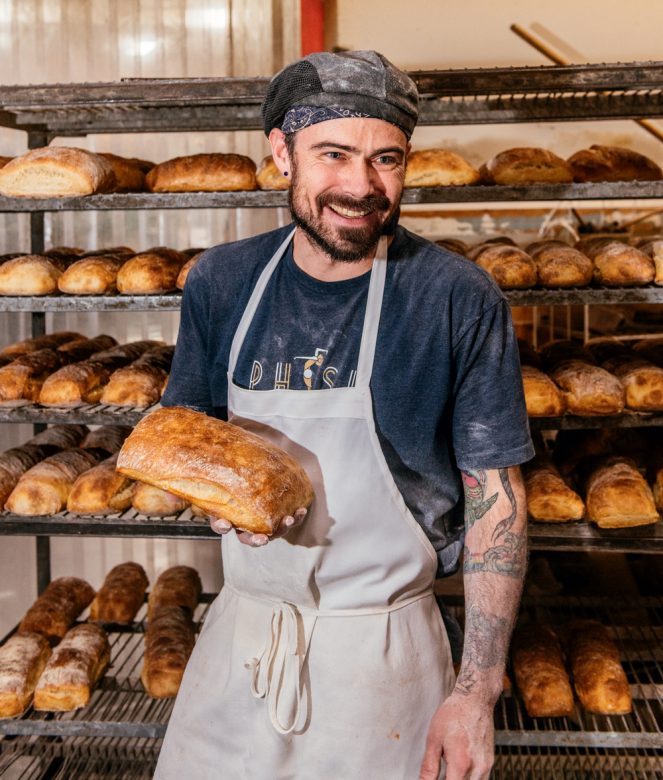
Photo Credit : Gabriela Herman
Berkshire Mountain Bakery, Housatonic: A famed sourdough bakery offering fluffy ciabatta, deeply caramelized canelés, and plenty more to build a perfect picnic. berkshiremountainbakery.com
Bizalion’s, Great Barrington: This shop imports its own olive oil, which you can buy directly from large drums or enjoy on a heaping pile of fresh arugula with lemon, Parmigiano-Reggiano, and perfectly sliced prosciutto. bizalions.com
Donaji, Great Barrington: A new local favorite, with authentic tacos and great margaritas. The al pastor and carnitas are some of the best in New England, and the chile relleno torta, when available, is an ideal blend of bread, spice, and cheese. donajimexicanrestaurant.com
The Lantern Bar & Grill, Pittsfield: Food for the people—great burgers, fried chicken, Caesar salads—from Bjorn Somlo, creator of the beloved upscale farm-to-table place Nudel, in Lenox. thelanternbarandgrill.com
Mezze, Williamstown: Vegetable-forward comfort food on a menu that lends itself to many small plates for sharing. Chef Nicholas Moulton has a particular talent with wild mushrooms and Brussels sprouts. mezzerestaurant.com
The Old Inn on the Green, New Malborough: The local go-to for special occasions, with midweek prix fixe deals making it affordable in the off-season. The dining room is lit only with candlelight, and the staff is always happy to save a table by the fireplace. oldinn.com
Public, North Adams: A busy pub-style place downtown that’s packed with locals. The beer list is impressive, and dishes range from shrimp and grits to burgers and grain bowls. publiceatanddrink.com
Rubi’s, Great Barrington: Being attached to Rubiner’s, the best cheese shop this side of the Hudson, pays dividends at this coffee shop, where lunch is fancy grilled cheese (from an extensive menu) or a prosciutto-and-butter sandwich. rubiners.com
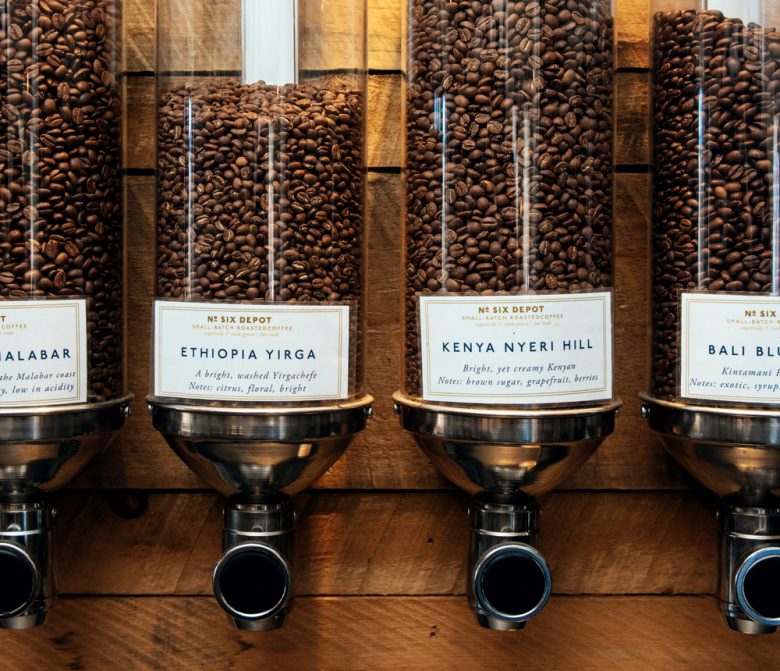
Photo Credit : Gabriela Herman
Six Depot, West Stockbridge: The people-watching and the coffee (roasted on-site) are top-notch at this café-gallery. For lunch there’s panini, with choices including flank steak with chimichurri and a tempeh reuben with local sauerkraut. sixdepot.com
Steam, Great Barrington: This noodle joint feels more like a street-food stand than a sit-down restaurant, with a mix of ready-to-go dumplings in the case and items cooked to order, like big bowls of ramen and fried gyoza. steam.restaurant
Stockbridge Coffee & TEA, Stockbridge: Come for a cuppa, and stay for a used book selection that can keep you occupied all afternoon. stockbridgecoffeeandtea.com
Widow Bingham’s Tavern at the Red Lion Inn, Stockbridge: The tavern vibe is very 19th century, and if you can score the booth it’s almost like having your own little private room. redlioninn.com
Berkshires Shopping
Charles H. Baldwin & Sons, West Stockbridge: Both the home of a famous (and fantastic) vanilla extract since 1888 and a quirky gift shop filled with treasures, including an old-time photo booth complete with props. baldwinextracts.com
One Mercantile, Great Barrington: With a focus on reusables for the kitchen, this housewares shop has a young and colorful aesthetic with something in every price range. Around the corner: the owners’ second venture, Sett, featuring all things tabletop. sett.onemercantile.com
Shaker Mill Books, West Stockbridge: Founded by the former longtime owner of the Bookloft in Great Barrington, this is a book lover’s dream—new, used, vintage, rare—in an iconic mill on the river. shakermillbooks.com
Township Four, Pittsfield: A floral design business that’s like stepping into an enchanted garden. It also sells antiques and plants, offers wall space to local artists, and hosts monthly classes. townshipfour.com
Yellow House Books, Great Barrington: Packed to the brim with prime used books, including a wall of ever-revolving stacks of new acquisitions right by the register. On Facebook
Berkshires Lodging
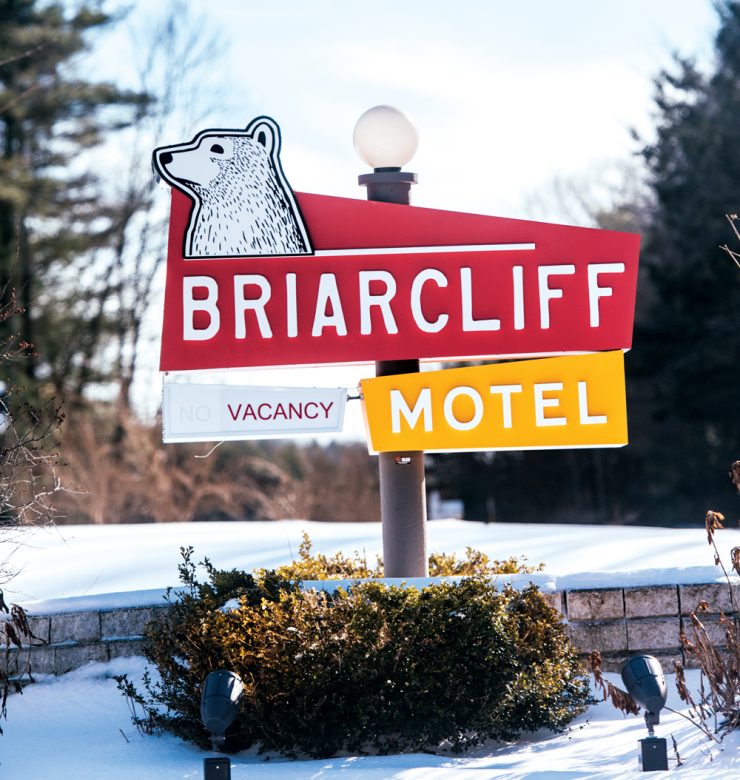
Photo Credit : Gabriela Herman
Briarcliff, Great Barrington: Family- and dog-friendly, an affordable updated motel nestled at the base of Monument Mountain with a massive firepit that blazes on the coldest winter nights. thebriarcliffmotel.com
Hotel on North, Pittsfield: A newer hotel with a grand-old-city-hotel vibe, lush with velvet couches and rich colors. The hotel’s restaurant is also a great spot for drinks and oysters. hotelonnorth.com
The Inn at Kenmore Hall, Richmond: A luxe B&B with nine fireplaces and at least as many comfortable couches for enjoying them. One suite has an entire room dedicated to a massive soaking tub. theinnatkenmorehall.com
Tourists, North Adams: Hang out by the fireplace in the lounge, or in the Airport Rooms bar with a classic cocktail and a retro wedge salad. Throughout the property, a custom playlist always provides the right soundtrack. touristswelcome.com
Berkshires Things to Do
Bartholomew’s Cobble, Sheffield: This National Natural Landmark is popular with snowshoers and home to one of the most diverse communities of plants in the area. thetrustees.org
The Clark, Williamstown: The buildings are as stunning as the Impressionist artwork inside. Don’t miss the smaller galleries in the library and the woodsy Lunder Center at Stone Hill. clarkart.edu
Kennedy Park, Lenox: With 15 miles of trails on 500 acres, there’s a route for every hiker, cross-country skier, and mountain biker. Stop into the Arcadian Shop in Lenox for a map (there’s a park entrance right off the parking lot). lenox.org/kennedy-park
Mass MoCA, North Adams: One of the biggest contemporary art museums in the country, and you’ll want to see it all. Doable in a day: Check out Sol LeWitt and James Turrell, then pick one or two more exhibits to take in. massmoca.org
The Mount, Lenox: Tours of author Edith Wharton’s home are intimate and in-depth, inviting you to immerse yourself in the imagination of its original owner. edithwharton.org
Norman Rockwell Museum, Stockbridge: It’s worth the trip just to come face-to-face with Rockwell’s originals, but the rotating exhibitions are an equal draw. (Now through May: “Finding Home: Four Artists’ Journeys.”) nrm.org
Ski Butternut, Great Barrington: A cozy ski mountain where the tubing is particularly fun and affordable, complete with a “magic carpet” to bring you back up the hill. skibutternut.com
Turnpark Art Space, West Stockbridge: This sculpture park overlooks West Stockbridge, and the wide loop that leads you from sculpture to sculpture feels more of an experience than an exhibit. Most of all, the chance to see West Stockbridge from above is not to be missed. turnpark.com
Williams College Museum of Art, Williamstown: A free museum right in the center of town, where the exhibitions are always engaging and the gift shop is a worthy stop in its own right. wcma.williams.edu








Do not miss Pleasant and Main in Housatonic just outside Great Barrington ! A little disappointed you did not mention them, they have the best breakfast / brunch !
How do you forget to mention the beauty that is the National Shrine of the Divine Mercy in Stockbridge?
Your article brought back many fond memories of my childhood in the 1950s. We always took a trip in the fall and I remember the trading post where you could buy Indian crafts but was impressed me was the Indian Chief in his warbonnet greeting the visitors
That brings back a lot of memories from the north.
Can’t believe no mention of Jiminy Peak ski resort, The Powder Hounds, (at the base of the mountain-with the best garlic mashed potates you will find) or the Mill in the Floss resturant.
I am commenting on the many people who miss judge this article its GREAT . If every place that was GREAT was mentioned It would take pages and pages Great job on this article , Thank you for the memories
I’m heading there next week, thanks for all the lovely recommendations!
Perhaps you should have mentioned more places to visit rather then so many restaurants and lodgings – such as the lovely drive up to Mt. Greylock, a
tour of Naumkeag, or Ventfort Hall – wherever your interests lie – aside from food!
I lived in Dalton ,Ma:home of Crane and Co a treasure to say the least ! I grew up there and loved my home town and it’s history
Excellent article touching on a mix of the old and new. Comical how people say “you forgot this or that…”. This is written from her PoV, if she was writing the penultimate tour guide perhaps it would have contained the places “she missed”…oh my….